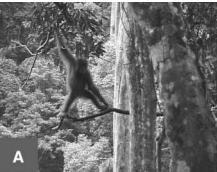Walking upright is one of the defining features of humans, separating us from the rest of the living apes. So it’s hardly surprising that the origins of bipedalism are a subject of great interest to palaeoanthropologists. Even I’ve probably spent more time dwelling on the subject than is healthy (particularly when arguing with Answers in Genesis. That’s never good for you). Yet despite all of these posts, I’ve never really addressed the ultimate question: just why do we walk upright?

Dart’s discovery, Taung Child, was the first hint something was wrong with the infamous Piltdown Man
This is a question that has been perplexing evolutionary anthropologists since Darwin himself1, but – like so many tv shows – didn’t get interesting for quite a while. In the 1920s Raymond Dart was working in South Africa, where he discovered the first fossils of Australopithecus, a 4 – 2 million year old, ape-like human ancestor2. This place the origin of our species in Africa and with it scientists could really get cracking on figuring out why we’re bipedal.
Dart’s own hypothesis was that it was linked to the African Savannah. Our non-bipedal ancestors moved out of the forest where all the other apes lived into this exciting new environment. There, they encountered some evolutionary pressure that drove them to become bipedal3.
Since Dart scientists have debated just what that pressure was. Some think it was the heat of the sun. By walking upright our ancestors would’ve exposed less surface area to that fiery ball of death than if they were walking on all fours4 (an idea closely linked to the thermoregulatory explanations for our lack of hair). Others thought the added height of walking upright would’ve allowed us to see further and spot (and thus avoid) predators5. The list goes on and I’ve got better things to do than type it all out.
However, some researchers question whether or not a non-bipedal hominin could survive on the open Savannah (a hominin, fyi, is a human member of the human family that lived after we split from chimps). If there truly was such a strong push to become bipedal, would the intermediate stages have been able to survive? An animal that is dying of heat stroke or a case of lion around the throat isn’t going to do much evolving after all6.

Living in the cliffs is how modern Savannah primates, like baboons, survive
Enter the recent “complex topography hypothesis” (or if you want to sound less pretentious, the “hiding in the rocks hypothesis”). The CTH argues that our ancestors lived on the sides of cliffs or rocky outcrops where they would be protected from the worst the Savannah had to offer. However, they would’ve still spent enough time on the ground gathering food (maybe even occasionally venturing out onto the deadly deadly Savannah) for evolution to push them towards upright walking6.
The CTH does certainly have some compelling evidence to support it, such as the fact that a good proportion of hominin fossils are found in these “topographically complex” environments. More than can be explained by chance. It also has some interesting implications. For example, early bipeds retained many ape-like features that were thought to be adaptations for tree climbing retained by an animal that hadn’t fully abandoned the trees yet. But under the CTH these climbing adaptations are actually so that our ancestors could scamper over rocks and up cliffs6!
The CTH is so new that it hasn’t been properly dissected by the rest of the scientific community yet, so I can offer no academic disembowlings a la Richmond & Strait. In fact, at the time of writing only 2 other articles have mentioned it, according to Google Scholar (the most prestigious of all academic websites), one of which is a news article about the hypothesis!
However, I do have some problems of my own with the CTH. The main one is that even our earliest ancestors were at least partly bipedal, predating our migration into the Savannah (or any rocky environment within the Savannah). This is something the CTH can’t explain, and that the paper on it conveniently ignores. They make no reference of any fossils older than ~4 million years ago6, whilst the earliest evidence of bipedalism stretches back 7 million years5!
Sahelanthropus tchadensis, the first member of the human family since we split from chimps, lived in a mixture of woodland, desert and swamp5,7 yet has a foramen magnum that suggests it was already upright8. In fact all of the early hominins had some bipedal capacity whilst still living in the forest. It would seem the story of human evolution is one of us getting good at walking upright, rather than inventing it from scratch somewhere on the Savannah.

An orang-utan walking along a branch
This has led many scientists to conclude that the forests these early bipeds were living in is the key to this whole debate. After watching orang-utans move through the trees, a team of scientists discovered that they tend to “walk” over thin branches in a manner very similar to how we walk along the ground9. It appears that life in the trees prepared our ancestors for upright walking, making the transition to life on the ground relatively easy.
So when they eventually wound up on the Savannah they wouldn’t have been immediately murdered by lions, but could survive long enough for other evolutionary pressures (perhaps those identified by Dart, all those years ago) to take effect. Our ancestors became better and better bipeds, refining the design they developed in the trees 7 million years ago until they abandoned the forests entirely. By about 2 million years ago the modern human body plan had been perfected in the form of Homo erectus (Latin for “upright man”).
And the rest, as they say, is (pre)history.
References & Notes
- Hawks, 2005. Why be bipedal? Accesed 15/10/13 from http://johnhawks.net/weblog/topics/bipedalism/why_be_bipedal.html
- Klein, R. G. (1989). The human career. Chicago: University of Chicago Press.
-
DART, R.A. 1925. Australopithecus africanus: the man-ape of South Africa. Nature 115: 195–99
- Ruxton, G. D., & Wilkinson, D. M. (2011). Avoidance of overheating and selection for both hair loss and bipedality in hominins. Proceedings of the National Academy of Sciences, 108(52), 20965-20969.
- Boyd, R., Silk, J. B., Walker, P. L., & Hagen, E. H. (2000). How humans evolved New York: WW Norton.
- Winder, I. C., King, G. C., Deves, M., & Bailey, G. N. (2013). Complex topography and human evolution: the missing link. Antiquity, 87, 333-349.
- Note: The environmental record can be formed over thousands (if not millions) of years, so just because those 3 environments have been found with Sahelanthropus doesn’t mean they all existed at the same time
- Russo, G. A., & Kirk, E. C. (2013). Foramen magnum position in bipedal mammals. Journal of human evolution.
- Thorpe, S. K., Holder, R. L., & Crompton, R. H. (2007). Origin of human bipedalism as an adaptation for locomotion on flexible branches. Science,316(5829), 1328-1331.

